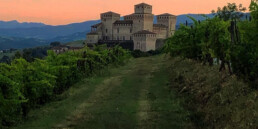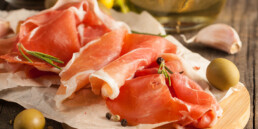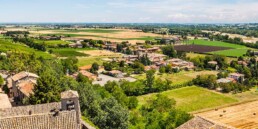CULTURE
Benedictine Abbey of Santa Maria della Neve
On the bank of the river Parma, the delightful abbey built in 1471 by the Count Pier Maria Rossi for his natural son Ugolino, abbot of the church of San Giovanni Evangelista in Parma. The visitor is welcomed by monks who still live there and is impressed by the beautiful artistic wealth of the place: a wonderful monastic complex dating back to the fifteenth century that includes an ancient Romanesque church built around a Renaissance cloister.
In the church you can admire the magnificent fresco of the “Madonna and Child” painted by Jacopo Loschi which dates back to the end of the 15th century.
But the most pleasant jewels is the eighteenth century Belvedere, located on the banks of the Parma River, adorned by an iron railing and embellished by some wonderful frescoes with smiling faces of putti, that seem to blow a cool breeze over the riverbed. You can also see gardens and vineyards cared for by the monks of the Badia and the soothing scenery of the valley, framed by gentle hills.
The abbey provides hospitality to the visitor and has a valuable apistic laboratory for the production and sale of cosmetics and herbal products, obtained from the ancient recipes handed down from the historical pharmacy of S. Giovanni Evangelista in Parma.
Not far from the castle of Torrechiara, the visitor sees on the bank of the river Parma, the delightful abbey built in 1471 by the Count Pier Maria Rossi for his natural son Ugolino, abbot of the church of San Giovanni Evangelista in Parma.
The visitor is welcomed by monks who still live there and is impressed by the beautiful artistic wealth of the place:
a wonderful monastic complex dating back to the fifteenth century that includes an ancient Romanesque church built around a Renaissance cloister, similar to the castle courtyard.
Under the “portico” of the cloister, there is the ancient bell with dedication by Pier Maria Rossi and the beautiful fifteenth – century terracotta tile with “the Flagellation” which reproduces the marble group of Amadeo in the Cathedral of Cremona.
WHERE
Via Badia, n.26
Torrechiara - Langhirano (Parma)
HOW TO VISIT
The monks receive individuals, groups of visitors and pilgrims: it is advisable to announce the visit.
WHEN
Monday - Saturday: 9-12
Sunday and Summer: 11-12/ 15-17
CONTACTS
Phone number 1: +39 0521.355203
Phone number 2: +39 328.1129454
CULTURE
Parma Ham Museum
In Langhirano, ‘’the capital of Prosciutto from Parma’’ has its seat the Parma Ham Museum located inside the completely restored complex of the Foro Boario, a splendid rural architecture of the twentieth century, which was historically destinated to the bargaining of livestock.
The museum reconstructs the production of Parma cured meats products and it accompanies the visitor in a parallel itinerary, starting from the ancient norcineria up to methodologies of the modern production. The exhibition itinerary is organised in eight sections and starts from the territory with the description of agricolture in Parma, closely linked to the rearings of pigs. The second section is dedicated to pig breads while in the next section it is explained the importance of salt for the preservation of meat.
The fourth room is dedicated to norcineria and collects in addition to numerous historical documents based on the activity of slaughtering pigs, a large collection of ancient instruments and objects.
The others sections focus on the other typical cured meats produced in the Parma area, on gastronomy, on ham processing techniques and on the role of the Prosciutto of Parma Consortium, that guarantees the quality of this extraordinary product, famous and appreciated all over the world. At the end of the exhibition, the visitor can admire a short excursus focus on the rich food production in Parma.
Dulcis in fundo, you can taste ham! In fact,you can enter into a tasting room, a real ‘’ham shop’’ where you will learn to taste the product and to appreciate its quality, to recognise the ham seasoning , the characteristics and the flavour. You can also taste, a wide selection of Colli of Parma wines. The museum also has a book shop with publications, gadgets and a select resale products typical of the territory.
WHERE
Via Bocchialini, n. 7
43013 - Langhirano (Parma)
HOW TO VISIT
The ham Museum welcomes individuals and groups of visitors, the visit is also possible with audio guides (rental on site) or with guided tour (advance booking).
WHEN
From March 1st to December 8th
Saturday, Sunday and holidays: 10 - 18
From Monday to Friday: open only by reservation with guided tour. From small group, from 1 to 5 participants, a supplement is required.
From December to February:
Closed - Open only by reservation
CONTACTS
E-mail: gestionemusei@gmail.com
Phone number: +39 340.1939057
Web site: https://prosciuttodiparma.museidelcibo.it/
CULTURE
Museum of the Risorgimento dedicated to Faustino Tanara
A rich correspondence between the colonel and the main protagonists of the Italian Risorgimento movement, first of all Garibaldi and Mazzini.
The magnificent Gallery of the Cultural Center of Langhirano, welcomes the visitor with the precious collection of the Museum of Risorgimento Faustino Tanara, dedicated to the talented patriot and colonel ‘’garibaldino langhiranese’’.
The Tanara collection, preserve relics dating back to the Risorgimento, documents and letters related to the figure of Faustino Tanara, but also linked to the local republican tradition and to the Artisan brotherhood Artigiana Langhiranese, founded by Tanara and presided over by Giuseppe Garibaldi.
The main corpus of the collection consists of the rich correspondence between the colonel and the main protagonists of the Italian Risorgimento movement, first of all Garibaldi and Mazzini; the visitor can also admire an intense exchange of letters between the “fighter” Faustino and his wife.
WHERE
Centro Culturale di Langhirano
Via Battisti n. 20, 43013 - Langhirano (Parma)
HOW TO VISIT
Free admission.
It is advisable to book the visit for groups or schools.
WHEN
Opening on weekdays,
times to check by phone.
CONTACTS
Phone number 1: +39 0521.351357
Phone number 2: +39 0521.351352
E-mail: info@museotanara.it
Web site: www.museotanara.it
CULTURE
Foundation Gastone Biggi
The Gastone Biggi Foundation, aims to protect the artistic heritage of Gastone Biggi.
The Gastone Biggi Foundation of Tordenaso, located in the homonymous hamlet of the Municipality of Langhirano, was founded in 2015 in order to promote the study and the works of Gastone Biggi. Within the foundation there are numerous artistic and poetic testimonies of the artist’s works.
Gastone Biggi, born in Rome in 1925, was an established painter, poet, writer and essayist of the last century, who established himself in the eternal city and then moved to Tordenaso, his ‘’place of adoption’’ where he died in 2014. He initially approached the painting and realism of artists such as Daumier and Goya and then created a working relationship with the group of Portonaccio (Muccini and Vespignani). He also had a dialogue with painters such as Dorazio, Scialoja, Turcato and Perilli. He is considered a multifaceted artist strongly influenced by Realism, by the Art of the Informal and by the American abstract Expressionism of Kline and Pollock. The key to reading Biggi’s works is to be found in the constant dialogue with atonal music through which he had the opportunity to explain the accent of words.
WHERE
Strada Tordenaso n. 21A
43013 - Langhirano (Parma) - Italy
HOW TO VISIT
Free admission,
only by reservation.
WHEN
Always open,
only by reservation.
CONTACTS
Phone number 1: +39 0521.1523525
Phone number 2: +39 331.7500238
E-mail: studiuniti@tiscali.it
Web site: http://www.gastonebiggi.com/gastone-biggi-2/#homeBox
CULTURE
Emanuele Modica, the painter of the tent
Inside the rectory of the church of Manzano, near Langhirano, you can admire the works created by the artist of Palermo origins, Emanuele Modica, who had appreciation by important art critics, journalists, writers and poets such as Ignazio Buttitta, Leonardo Sciascia, Vittorio Sgarbi, Michele Prisco, Lorenzo Piras, Gianni Bertone, Cesare Zavattini and Gianni Cavazzini.
Emanuele Modica was born in Palermo, on November , 29, 1936 in a pesant family of 7 children. As a child, he manifested great attention and passion for art and painting. He saw stains on the walls of the barn, human profiles and hidden images.
At the age of 24, he was struck by the death of his father killed by the Mafia. Working as a bartender, he began to create the first drawings with coffee on receipts.
Discovered by the Palermo gallerist Ciro Livigni, in 1968 Modica, decided to become but in his own way, as ‘’a solitary navigator’’ as his friend Don Luigi Ciotti, defined him.
Emanuele Modica, commonly known as the painter of the tent, in 1969, creates in Palermo ‘’the tent’’ an itinerant exhibition that takes him through the squares of Italy with his tent, touching threats, prayers and intimidation.
Among, its stops, are remembered those in the ‘’difficult’’ squares of Palermo, Sicily and Naples in the 70s, while in Northern Italy those of Aosta, Parma, Biella and Riccione and the last in the gardens of Villa Mussolini, where he received the visit of Vittorio Sgarbi.
The last stage was that of Bergamo, a few years ago, when due to an illness, he was forced to give up his ‘’artistic nomadism’’ to move with his wife to Manzano in Langhirano.
In the rectory of the parish church, he continued his artistic career with the realization of some restorations and works such as the Pietà, the Colomba della Pace and San Vincenzo, a painting dedicated to the Saint patron, located near the façade.
He received numerous appreciations from art critics, journalists, writers and poets. Hi history and his works have been presented on the main national television network such as RAI and MEDIASET.
WHERE
Canonica Chiesa di Manzano, n. 15
Manzanodi - Langhirano (Parma)
HOW TO VISIT
Free admission,
only by reservation.
WHEN
Always open,
only by reservation.
CONTACTS
For information on opening hours contact:
Phone number: +39 0521.857148
E-mail: info@parrocchialanghirano.it




